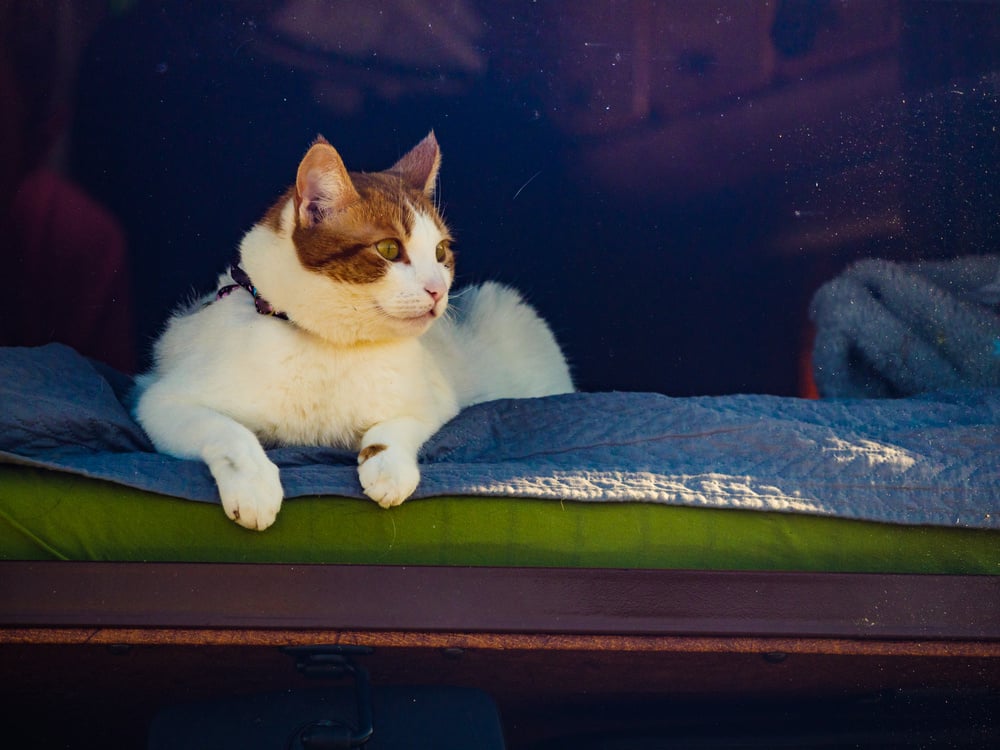Are fairy lights and flags on caravans tasteful or tacky?
If you’re a cat owner, you might wonder if it’s possible to bring your feline companion along for the ride when you travel in your caravan, especially if you’re off on holiday and you can’t find a cat sitter. The good news is that with a little planning and preparation, taking your cat on a caravan holiday can work, and it can be an enjoyable experience for both you and your cat. Here’s everything you need to know to make sure it goes swimmingly…
Preparing your cat for travel
Cats are creatures of habit, and introducing them to a new environment like a caravan can be unsettling. To make the transition easier, get them used to the caravan well in advance. Spend time with your cat inside the caravan while it’s stationary, allowing them to explore the space, find hiding spots, and get comfortable with their new surroundings.
If your cat isn’t used to travelling in a carrier, now’s the time to get them accustomed to it. Make the carrier a positive place by adding their favourite blanket, toys and perhaps some treats. It’s essential for both their safety and comfort during the drive, as there will be times when you don’t want them roaming freely.
Take your cat on some short practice drives (ideally in the car first) to help them adapt to the movement of the caravan. Some cats can experience motion sickness, so it’s helpful to gauge their reaction early on.
Pet passports issued in Great Britain are no longer valid to enter the EU, so depending on where you are going, you might need to take other documents with you. An Animal Health Certificate (issued by your vet) is needed for each journey you make to Europe or Northern Ireland, regardless of whether your pet has travelled there before or not. Make sure they’ve had the necessary vaccinations too, before you travel, which includes rabies if you are going to the EU or Northern Ireland.
You must get your cat microchipped before, or at the same time as, their rabies vaccination - if you don’t, they’ll need to be vaccinated again.
The rules on taking cats abroad can be found here.

Packing the essentials
Just like packing for yourself, your cat will need their own set of essentials for the trip. Here’s what to include…
Litter box
A compact, easily accessible litter tray is a must. Some owners prefer to use disposable liners for easy cleaning.
Food and water
Make sure to bring your cat’s regular food and make sure plenty of fresh water is available. Travel bowls that minimise spillages are ideal in a caravan, and collapsible ones are good for when you are out and about - and easy to store when space is limited.
If you are going abroad, find out in advance if you are allowed to take meat and dairy into the country, if that is what your cat eats.
Toys and comfort items
Familiar toys, blankets or bedding can help reduce anxiety and make your cat feel at home, as they love the smell of something familiar.
Medication
If your cat requires medication, ensure you have enough with you for the trip.
Collar and ID tag
Even if your cat is microchipped, a collar with an up-to-date ID tag is crucial in case they get lost.
Keeping your cat safe
Safety is paramount when travelling in a moving vehicle, so here are a few things to keep in mind…
Cats should never roam freely inside the caravan while it’s moving. For their safety, keep them in a secure, well-ventilated carrier. Depending on your setup, you’d ideally be able to fit pet seatbelts or attach the carrier to a secure point.

Watch out for the temperature. Caravans can heat up quickly, especially in summer. Make sure your cat is in a well-ventilated area and never leave them unattended in a hot vehicle.
If you plan to let your cat outside during rest stops, consider lead training them before the trip. A cat harness is a great way to let them explore safely.
Settling in
Once you’ve arrived at your destination, it’s time to settle in.
Cats need a safe space, so designate a quiet area in the caravan where your cat can retreat to if they feel overwhelmed. Their crate or carrier can serve as a safe spot, away from any noise.
Obviously you may need fresh air coming in, but do ensure that windows, doors, and roof vents are secure to prevent your cat from sneaking out without you knowing. Be mindful, too, of the local wildlife, traffic and other potential animals at campsites that could pose a risk.
It’s good to keep to the same sort of routine as at home, if you can. Stick to your cat’s regular feeding times as much as possible. Cats thrive on routine, and keeping familiar patterns will help them adjust to their new environment.
Handling anxiety and stress
Travelling can be stressful for some cats, especially those who are naturally more anxious. If you notice signs of stress, such as excessive meowing, hiding, or refusal to eat, there are some things you can do.
Cats always need to be able to hide, as it helps them to feel safe, so having something as simple as a cardboard box to serve this purpose is ideal.
You can get calming aids, such as pheromone sprays or calming collars, to help alleviate stress - speak to your vet for recommendations.
Offer plenty of praise, treats and reassurance to help your cat associate travel with positive experiences.
If your cat seems particularly stressed, consider stopping more frequently during your journey to allow them to calm down.
Exploring the great outdoors
If your cat is lead-trained and comfortable outdoors, caravan trips can be a great way to introduce them to new environments safely. Choose animal-friendly campsites - some caravan parks are more pet-friendly than others, with specific areas designated for walking pets.
Always check ahead to ensure your chosen site welcomes cats.
So there it is - your guide to safe touring with your cat. Let us know below if you’ve taken your cat away with you before, or if it’s something you are considering. We love to hear your views!








